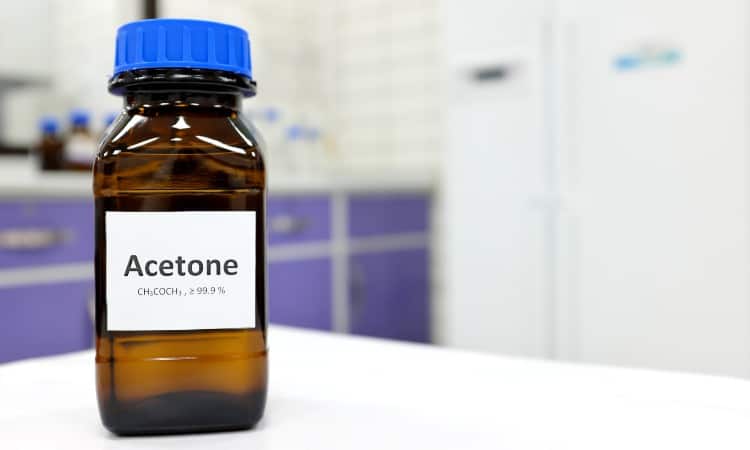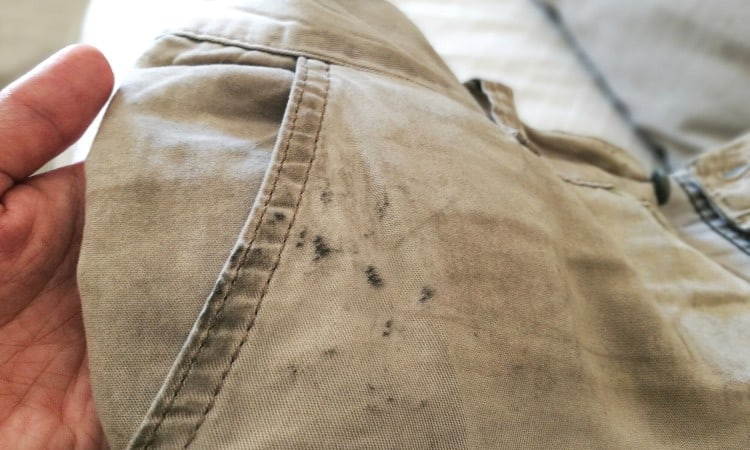Acetone is a useful chemical when it comes to removing nail polish. It’s even handy for removing grease stains. Every so often, spillages are bound to occur. Which begs the question: does acetone stain clothes?
Often found in nail polish remover, acetone is a colorless liquid. While it damages some fabrics, it can remove grease stains in colorfast material. Make sure the acetone isn’t blended with other chemicals as they may cause stains. Avoid using acetone on modacrylic, acetate, and triacetate fabrics.
This article will answer the question: does acetone stain clothes? Read on to learn how to avoid staining your clothes and what stains you can remove with acetone.

Does Acetone Stain Fabric?
Acetone can stain some fabrics, particularly if acetone has been blended with other chemicals. Not only that, but for fabrics containing modacrylic, acetate, or triacetate fibers, acetone can be disastrous. They are essentially plastics. As acetone is a solvent known to eat plastic, it can dissolve these fabrics in the blink of an eye.
Rather than causing stains, acetone can damage natural fibers like silk and wool. You need to make sure you know what your garment or furniture coverings are made of before attempting to remove stains using acetone.
Although it isn’t much you can do to repair a dissolved or damaged fabric, stains left behind by acetone can be removed by using a stain remover in your wash. One thing to be wary of, acetone has been known to remove the color from fabric.
As a solvent known for removing nail polish, it can’t tell the difference between colors you want to keep and those you don’t. The removal of the fabric’s color can sometimes look like a stain. Before attempting to remove nail polish from clothing with acetone, make sure your garment is colorfast.
What Is Acetone Made Of?
Although the name acetone conjures up images of a chemical substance, it is an organic compound.
Also known as propanone, acetone contains carbon, hydrogen, and oxygen and forms a colorless liquid that is highly flammable.
Acetone’s unique organic structure can break down oils, fats, rubber, and plastics. It can be found in the home in the form of nail polish remover, paint thinner, and in some cosmetics and facial treatments. Our bodies produce acetone as a natural by-product of metabolism.
When used correctly and in the right amount, it’s considered to be non-toxic. However, some chemically created blends of acetone are strong enough to clean up oil spills. They can even be added to gasoline to improve fuel efficiency.
Using Acetone to Remove Grease Stains

One of the strengths of acetone is its ability to eat oils. Grease is a type of oil which is why this kind of stain can be tricky to remove. If you have a greasy stain on your clothing, acetone could be just the thing you need to get rid of it.
A word of caution first though, acetone isn’t the best thing to use on plastic-based fabrics. As it’s a strong solvent used to break down plastics, any kind of synthetic material will have a very bad experience if it comes into contact with acetone. Similarly, wool, silk, and any fabric that isn’t colorfast can be irreparably damaged.
Always test a small area of the garment that can’t be seen. Like inside the seam allowance, for instance. Use the tiniest amount of acetone and watch for any adverse effects. Better to ruin a small part of your seam than the whole shirt or dress!
Another thing to be aware of is some acetone products are mixed with other chemicals. Using an acetone blend could end up adding to your stain problems rather than removing them! You may find the chemicals used to boost the properties of the acetone will bleach your fabric.
The easiest way to buy acetone is as a nail polish remover. Because this is used next to the skin and on nails, they can have additives like conditioners and other substances to help boost the health of nails. It’s these other substances you need to steer clear of when you need the acetone to remove stains.
Try to stick to pure acetone products for removing grease stains as these are less likely to bleach the color out of your clothing or leave residue on the garment.
To remove grease spots from clothing, you will need an old towel and some acetone. Then, simply follow these steps:
Step 1
Roll up the old towel and place it on a flat surface. Turn your garment inside out and place the stained area directly over the rolled-up towel.
Step 2
Taking care not to get acetone on your work surface, slowly pour it onto the stain. You should see the grease stain lift as the acetone works its magic. If nothing noticeable happens, keep adding the acetone. One of the issues with grease and oil stains is they can bury themselves deep inside the fibers of the fabric, so it may take a couple of attempts.
Step 3
Once you see a result with the acetone, take your garment to the washroom and launder as usual.
Step 4
If you can still see signs of the grease spot after washing, repeat steps 1-3 until you are happy with the results.
Does Acetone Leave Residue?
If you find that using acetone to remove grease stains has left a mark behind, it’s probably residue. Using acetone mixed with other chemicals can lead to some residual staining.
Acetone is colorless and tends to evaporate quickly. Pure acetone is therefore unlikely to leave any trace behind. Problems start to occur when you’re dealing with an acetone blend.
The key to removing residue stains is to act fast. Make sure you start treatment on the stains before the acetone evaporates. You will need dishwashing liquid, lukewarm water, at least two clean rags, an old towel, and a teaspoon.
Step 1
Blot the spilled acetone with an old towel or absorbent cloth. If any solids are starting to form, gently scrape them up with the round end of a spoon or any other blunt implement.
Step 2
Grab your dishwashing liquid. You don’t want anything stronger than this as you don’t want to add soap stains to the mix. Steer clear of laundry detergent for this stage as that could take the color out of the clothes and the stain!
Step 3
Apply a mix of the dishwashing liquid and lukewarm water to the stain with the rag. You’re looking at 1/4 teaspoon of liquid to 1 cup of water. Gently work the mixture into the stain with a rag. Work from the outside to the center of the stain and use a dabbing motion. Don’t rub or use pressure as a heavy hand will cause more damage to the garment. Remember, gently does it! Continue this step until the stain has gone.
Step 4
With a clean rag, start to blot and soak up the acetone stain-dish liquid mix. Continue until the rag has soaked up all of the solution. You may need to use more than one rag to completely soak up the mixture for large areas.
Step 5
Rinse with cold water to make sure all the residue has been removed. Gently blot with a dry towel to lift any remaining moisture. Then wash your garment as you would normally.
Alternative Ways to Remove Nail Polish From Clothes
One of the top causes of acetone stains on clothes is using a nail polish remover containing the substance. The good news is, there are ways to remove your favorite nail colors without using acetone. Let’s look at the alternative methods available and see how they compare with acetone-based products.
Hairspray
I bet when you started this article, you never expected to read that hairspray can be used to remove nail polish. The second thing that might cause some surprise is it works best if you allow the polish to completely dry.
Once it’s dry, liberally spray on the hairspray and allow that to dry too. Using tweezers you can then scrape away the residue. It’ll come off in flakes. Once you have removed all the hairspray-polish flakes, wash your clothing as normal. This process can be repeated, so if there are still some nail polish marks on your clothes, simply saturate with hairspray once more!
This method works best on clothes and carpets. Although with carpet you might need to use a carpet brush instead of tweezers. The great thing about hairspray is it’s designed to be used near both clothes and carpeting so it won’t bleach the fabrics.
Acetone-Free Nail Polish Remover
 Normally used to remove the color from false nails, an acetone-free solution will not damage the plastic in your favorite brand of nail extensions. You can also use acetone-free nail polish remover on your nails too.
Normally used to remove the color from false nails, an acetone-free solution will not damage the plastic in your favorite brand of nail extensions. You can also use acetone-free nail polish remover on your nails too.
Acetone is a solvent strong enough to dissolve plastic. If it’s that harsh to inanimate objects, just think what it does to your nails! An acetone-free remover may not work as fast, but it will be more gentle on your skin and less harmful to your nails.
Nail polish removers that don’t contain acetone are also considered safer when it comes to getting nail polish out of fabric. Simply soak some cotton wool and blot the stain until most of it has come out. Then, wash as you would normally.
Rubbing Alcohol
 Although the hairspray and acetone-free solutions work well on fabrics, they can’t do much for leather. Leather is going to need something a bit stronger. But not acetone! That’s one substance that is a little too strong!
Rubbing alcohol should be applied to nail polish spills on leather. This needs to be done as soon as possible, preferably while the polish is still wet. Use a towel soaked in the alcohol to blot the stain. The wetness of the alcohol will absorb the nail polish.
Although the hairspray and acetone-free solutions work well on fabrics, they can’t do much for leather. Leather is going to need something a bit stronger. But not acetone! That’s one substance that is a little too strong!
Rubbing alcohol should be applied to nail polish spills on leather. This needs to be done as soon as possible, preferably while the polish is still wet. Use a towel soaked in the alcohol to blot the stain. The wetness of the alcohol will absorb the nail polish.
Mixing 2 parts white vinegar with 1 part olive oil, gently rub into the leather using a soft toothbrush. This should help lift out any remaining color from the polish. To keep your leather supple and smooth, apply some leather conditioner.
Conclusion
Acetone in its pure form is unlikely to cause stains on garments or other fabrics. It breaks down plastics, though, so it can cause damage to some synthetic materials. Additives like conditioners or other chemicals mixed with acetone can cause stains.
Let me know in the comments if you liked the article. Have you tried removing acetone stains from your clothes or carpet? How did you get on?